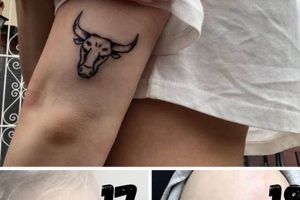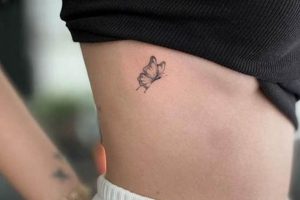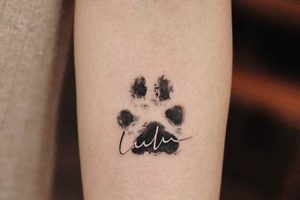A floral motif popular in body art, the lotus blossom carries symbolic weight across numerous cultures. Designs incorporating this image range from simple outlines to intricate depictions interwoven with other elements, like mandalas, koi fish, or script. Examples include a small, minimalist outline on the wrist or a large, detailed piece spanning the back, showcasing the flower emerging from murky water.
The enduring appeal of this aquatic flower stems from its rich symbolism. Representing purity, rebirth, and resilience, it embodies the ability to rise above adversity and blossom into something beautiful. This symbolism, rooted in Buddhist and Hindu traditions, makes it a powerful and personally meaningful choice for many seeking permanent body art. Historically, different colors have held different meanings, allowing for further personalization and depth.
Exploring the varied interpretations and artistic styles associated with this bloom can inspire unique and deeply personal tattoos. Considerations include placement, size, color palette, and the incorporation of additional symbolic elements to create a design reflecting individual experiences and values.
1. Placement
Placement is a crucial factor in the overall aesthetic and symbolic impact of a lotus flower tattoo. The chosen location on the body influences the design’s visibility, how it interacts with the body’s natural contours, and the conveyed message.
- Visibility and Discretion
A lotus blossom on the inner wrist offers a subtle, personal statement, easily concealed when desired. Conversely, a larger design on the back makes a bold statement, readily visible. The degree of visibility directly correlates with the individual’s comfort level and intended message.
- Body Contours and Flow
The natural curves of the body can be accentuated by strategically placed designs. A lotus flower flowing along the spine or encircling the arm creates a harmonious visual effect, enhancing both the tattoo and the body’s form. Placement should complement the body’s natural lines to create a balanced composition.
- Symbolic Significance through Placement
Placement can amplify the symbolic meaning of the lotus. For instance, a blossom positioned over the heart emphasizes its connection to love and purity, while a design emerging from water on the ankle might symbolize rising above challenges. Intentional placement enhances the narrative embedded within the tattoo.
- Size and Detail Considerations
Placement influences the level of detail and size achievable. Intricate designs require larger surface areas, making the back or thigh ideal locations. Smaller areas like the wrist or ankle are better suited for minimalist designs. Choosing the appropriate placement facilitates the desired level of artistic complexity.
Careful consideration of placement ensures the lotus flower tattoo harmonizes with the individual’s body and effectively conveys the intended symbolism. This thoughtful approach results in a meaningful and aesthetically pleasing piece of body art that resonates with the wearer’s personal narrative.
2. Size
The size of a lotus flower tattoo significantly impacts its visual impact and the level of detail achievable. Careful consideration of size is essential, ensuring the design aligns with the wearer’s aesthetic preferences and the intended message. Size influences not only the prominence of the tattoo but also its placement and the incorporation of additional elements.
- Small and Subtle
Small lotus flower tattoos offer a discreet yet elegant option. These designs, often minimalist in style, are ideal for placement on the wrist, ankle, or behind the ear. A small lotus blossom can symbolize personal growth or a quiet reminder of inner peace without drawing significant attention.
- Medium-Sized Designs
Medium-sized tattoos allow for greater detail and the incorporation of additional elements, such as leaves, stems, or geometric patterns. Common placements include the forearm, shoulder blade, or thigh. This size strikes a balance between visibility and subtlety, allowing for more intricate artwork while maintaining a degree of discretion.
- Large and Intricate
Large lotus flower tattoos offer a canvas for complex designs, incorporating vibrant colors, intricate shading, and accompanying elements like mandalas, koi fish, or script. These statement pieces often adorn the back, chest, or thigh, showcasing the artist’s skill and the wearer’s commitment to the symbolism. Large-scale designs allow for a comprehensive visual narrative.
- Proportion and Placement
The chosen size must harmonize with the intended placement and the body’s natural contours. A large, intricate design might overwhelm a smaller area like the wrist, while a small, minimalist tattoo might get lost on a larger area like the back. Proportionality ensures the design complements the body and maintains its visual integrity.
The size of a lotus flower tattoo should be a deliberate choice, reflecting the individual’s personal preferences and the desired level of symbolic expression. Whether small and subtle or large and intricate, the size significantly contributes to the overall aesthetic and meaning of the tattoo, ensuring it remains a powerful and personally resonant piece of art.
3. Color Symbolism
Color symbolism plays a vital role in the overall meaning and aesthetic impact of lotus flower tattoos. The chosen hues infuse the design with deeper layers of symbolism, drawing upon established cultural associations and personal interpretations. Selecting specific colors allows individuals to personalize their tattoos, conveying specific emotions, aspirations, or spiritual beliefs.
In various cultures, the lotus flower holds distinct color associations. A white lotus typically represents purity, enlightenment, and spiritual perfection. A red lotus signifies love, compassion, and passion. Blue, often associated with wisdom and knowledge, represents the victory of the spirit over the senses. Purple, a color of royalty and mysticism, can symbolize spiritual growth and transformation. A pink lotus often connects with historical figures like Buddha and represents devotion and spiritual awakening. Finally, a black lotus can symbolize mystery, rebellion, or overcoming adversity.
The practical significance of understanding color symbolism lies in the ability to create a tattoo that resonates deeply with personal values and aspirations. For example, an individual seeking to represent overcoming challenges might choose a black or blue lotus, while someone focusing on spiritual growth might opt for a purple or pink bloom. Furthermore, combining colors can create complex narratives within the tattoo. A design incorporating both red and white lotuses could symbolize the balance between passion and purity. The interplay of colors adds depth and richness to the overall design, transforming a simple floral motif into a powerful symbol of personal meaning.
4. Accompanying Elements
Accompanying elements significantly enhance the narrative and visual depth of lotus flower tattoos. These additions, ranging from simple geometric patterns to complex symbolic figures, transform the central floral motif into a personalized and multifaceted piece of art. The selection of accompanying elements should be deliberate, reflecting the individual’s personal story and desired symbolism. The incorporation of these elements creates a richer, more nuanced design that extends beyond the basic floral representation.
Common accompanying elements include mandalas, representing the universe and balance; koi fish, symbolizing perseverance and good fortune; and script, incorporating meaningful quotes or names. Geometric patterns can add a sense of structure and symmetry, while depictions of water, such as ripples or droplets, emphasize the lotus’s natural aquatic environment. These additions build upon the core symbolism of the lotus, creating a layered and personalized narrative. For example, a lotus combined with a mandala can represent the individual’s spiritual journey towards enlightenment, while a lotus paired with a koi fish might symbolize overcoming adversity and achieving success. The combination of elements allows for complex storytelling within the tattoo design.
The practical significance of understanding the role of accompanying elements lies in the ability to create a tattoo that resonates deeply with personal values and aspirations. By carefully selecting complementary imagery, individuals can craft a unique design that reflects their individual journey and beliefs. Thoughtful consideration of these elements elevates the lotus flower tattoo from a simple floral representation to a powerful symbol of personal meaning and artistic expression. It allows the wearer to communicate a complex narrative through a visual medium, transforming the skin into a canvas for self-expression.
5. Linework Style
Linework constitutes a fundamental element in tattoo design, significantly influencing the overall aesthetic and perceived texture of a lotus flower tattoo. Varying line weights, styles, and techniques contribute to the final visual impact, conveying different moods and artistic interpretations. Understanding the interplay between linework and the lotus motif allows for informed design choices that align with individual preferences and desired symbolism.
Fine, delicate lines create an impression of elegance and intricacy, ideal for detailed depictions of petals and subtle shading. This style lends itself well to smaller, minimalist designs or intricate patterns within larger compositions. Conversely, bold, thick lines create a strong, graphic statement, emphasizing the lotus’s outline and symbolic strength. This approach is often employed in traditional or tribal-inspired designs. Dotwork, a technique using clustered dots to create shading and texture, offers a unique textural dimension, adding depth and visual interest to the petals and leaves. Variations in line weight and style, such as combining fine lines for detail with bolder lines for outlines, add visual dynamism and depth, creating a more complex and engaging design.
Consider a fine-lined lotus blossom delicately placed on the wrist, embodying a sense of understated elegance. Contrast this with a bold, blackwork lotus spanning the back, expressing strength and resilience. These contrasting examples illustrate the profound impact of linework choices on the final aesthetic. The practical application of this understanding lies in the ability to select a linework style that complements the desired symbolism and placement of the lotus flower tattoo. Skillful linework elevates the design, transforming a simple floral representation into a piece of art that resonates with personal meaning and artistic vision. This conscious choice ensures the tattoo’s visual impact aligns with the wearer’s individual aesthetic and desired narrative.
6. Cultural Significance
Cultural significance plays a crucial role in the symbolism and design choices associated with lotus flower tattoos. Understanding the rich history and diverse interpretations across different cultures provides depth and authenticity to the chosen design. This cultural context informs not only the aesthetic choices but also the personal meaning embedded within the tattoo.
- Buddhism
In Buddhist traditions, the lotus flower represents purity, enlightenment, and rebirth. Emerging from murky water to blossom into a beautiful flower, it symbolizes the journey from suffering to spiritual awakening. This association makes it a popular choice for those seeking to represent their spiritual path or commitment to Buddhist principles. Different colors hold specific meanings within Buddhism, with white symbolizing mental purity and red representing the heart.
- Hinduism
Within Hinduism, the lotus flower holds similar significance, representing purity, beauty, and spiritual growth. It is often associated with deities like Lakshmi, the goddess of prosperity, and Brahma, the creator god. The lotus’s ability to thrive in challenging environments further emphasizes its symbolism of resilience and overcoming adversity. The flower’s connection to these deities adds another layer of meaning for those seeking to honor specific Hindu traditions.
- East Asian Cultures
Beyond specific religious contexts, the lotus flower holds broader cultural significance in East Asian cultures. It is often associated with purity, love, and harmony. In Chinese culture, for example, the lotus can symbolize marital harmony and good fortune. This broader cultural understanding allows for diverse interpretations and artistic expressions within tattoo designs, incorporating elements like dragons or phoenixes alongside the lotus to further enrich the symbolism.
- Modern Interpretations
While rooted in ancient traditions, the lotus flower’s symbolism continues to evolve in modern interpretations. It can represent personal growth, resilience, overcoming challenges, or simply an appreciation for natural beauty. This adaptability allows individuals to connect with the symbolism on a personal level, imbuing the tattoo with unique meaning that transcends traditional interpretations.
Appreciating the cultural significance of the lotus flower enriches the tattoo design process. By understanding the historical and symbolic weight associated with this motif, individuals can create tattoos that resonate deeply with personal values and cultural heritage. This connection to tradition elevates the lotus flower tattoo beyond a mere aesthetic choice, transforming it into a powerful symbol of personal and cultural identity.
Tips for Lotus Flower Tattoo Designs
Careful planning ensures a lotus flower tattoo effectively embodies desired aesthetics and symbolism. These tips provide practical guidance for navigating the design process, resulting in a meaningful and visually compelling piece of body art.
Tip 1: Research Symbolism: Thoroughly research the lotus flower’s diverse meanings across different cultures. This knowledge ensures the chosen design aligns with intended symbolism, adding depth and authenticity to the tattoo.
Tip 2: Consider Placement Carefully: Placement impacts visibility, interaction with body contours, and overall aesthetic. Consider how the tattoo will look on the specific body part and how its location complements the design.
Tip 3: Choose a Linework Style: Linework significantly influences the tattoo’s visual impact. Explore different styles, from delicate fine lines to bold outlines, to find a style that aligns with the desired aesthetic and symbolic representation.
Tip 4: Explore Color Symbolism: Different colors imbue the lotus flower with specific meanings. Research color associations to select hues that enhance the intended symbolism and create a visually appealing design.
Tip 5: Think About Accompanying Elements: Consider incorporating elements like mandalas, koi fish, or script to enrich the narrative and create a more complex design. These additions should complement the lotus flower and contribute to the overall symbolic meaning.
Tip 6: Consult with a Tattoo Artist: Collaborate with a reputable tattoo artist experienced in floral designs. A skilled artist can provide valuable input, refine the design, and ensure its successful execution.
Tip 7: Plan for Aftercare: Proper aftercare is essential for preserving the vibrancy and longevity of the tattoo. Follow the artist’s instructions diligently to ensure proper healing and prevent complications.
By following these tips, individuals can navigate the design process with confidence, resulting in a lotus flower tattoo that serves as a powerful symbol of personal meaning and artistic expression. A well-planned tattoo becomes a permanent piece of art that resonates with the wearer for years to come.
These preparatory steps ensure the final tattoo embodies both aesthetic appeal and deeply personal symbolism, resulting in a meaningful and enduring piece of art.
Frequently Asked Questions about Lotus Flower Tattoos
This section addresses common inquiries regarding lotus flower tattoos, providing factual information and clarifying potential misconceptions.
Question 1: How painful is a lotus flower tattoo?
Pain levels vary based on individual pain tolerance, placement, and tattoo size. Areas with thinner skin or closer to bone tend to be more sensitive. Consulting with a tattoo artist can provide more specific insights related to the chosen design and placement.
Question 2: How long does a lotus flower tattoo take?
The duration depends on the design’s complexity, size, and the artist’s skill. Small, minimalist designs might take an hour or less, while larger, more intricate pieces can require multiple sessions spanning several hours each.
Question 3: What is the average cost of a lotus flower tattoo?
Cost varies based on size, complexity, artist’s experience, and geographical location. It’s advisable to consult with several artists to obtain quotes and discuss design specifics before committing.
Question 4: How should a lotus flower tattoo be cared for?
Proper aftercare is essential for healing and preserving the tattoo’s vibrancy. Follow the artist’s specific aftercare instructions, which typically involve keeping the tattoo clean, moisturized, and protected from sun exposure.
Question 5: Can a lotus flower tattoo be covered up or removed?
Cover-ups and removals are possible but present challenges. Consult with a skilled tattoo artist specializing in cover-ups or a laser removal technician to discuss options and limitations. The complexity of the existing tattoo influences the success of these procedures.
Question 6: What are some unique lotus flower tattoo design ideas?
Unique designs can incorporate elements reflecting individual interests and experiences. Consider combining the lotus with other symbolic imagery, experimenting with color palettes, or incorporating personalized script. Consult with a tattoo artist to explore creative design possibilities.
Addressing these common questions provides a foundation for informed decision-making throughout the design and execution process. Consulting with a reputable tattoo artist further clarifies any remaining questions and ensures the final result aligns with individual expectations and artistic vision.
This information provides a comprehensive overview of key considerations for individuals contemplating a lotus flower tattoo. Further research and consultation with experienced professionals ensure informed decisions and a positive tattooing experience.
Conclusion
Exploring the multifaceted aspects of lotus flower tattoos reveals a rich tapestry of symbolic meaning and artistic expression. Placement, size, color symbolism, accompanying elements, and linework style all contribute to the final visual impact and personal resonance of the design. Understanding the cultural significance of the lotus flower across various traditions further enriches the narrative embedded within the tattoo. Careful consideration of these elements allows individuals to create deeply personalized designs that reflect their unique values, beliefs, and aspirations.
A lotus flower tattoo transcends mere aesthetics; it represents a powerful symbol of personal growth, resilience, and spiritual awakening. The enduring appeal of this floral motif lies in its ability to convey complex narratives through a visual medium. Ultimately, the lotus flower tattoo serves as a permanent reminder of inner strength, the beauty of overcoming adversity, and the continuous journey towards self-discovery. This enduring symbolism ensures the lotus flower remains a compelling choice for those seeking meaningful and aesthetically captivating body art.







